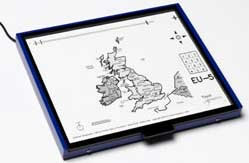Talking Touch Screens
Roland milling systems build 3D overlays for tactile tablets.
Latest News
December 13, 2007
By Sara Ferris
 Tactile touch tablets are useful tools for people with vision impairments. |
The Talking Tactile Tablet (US$699) is a simple computer device designed as a “viewer” for audio and tactile materials. A computer touch screen connects to a PC via a USB cable. A hinged frame on the touch screen opens and closes to secure a selected tactile graphic sheet in place against the touch-sensitive surface. The user presses points on the tactile sheet, and the device passes the coordinates to the computer. The computer provides audio feedback based on whatever part of the sheet was touched. Multimedia authoring tools such as Macromedia Director can be used to create interactive software titles for the Talking Tactile Tablet.
“The Talking Tactile Tablet is a very powerful way to get visual information to people with severe visual impairments,” said Steven Landau, president of Touch Graphics (New York, NY), the manufacturer of the device. “It makes it much easier for people to understand a map compared to just hearing words. Plus, you don’t have to be able to read Braille.”
The device also serves sighted people in applications such as a talking museum exhibit. Available applications for the Talking Tactile Tablet include a world atlas, two reading programs, and a touch version of the Snakes and Ladders game.
Touch Graphics uses a Roland MDX Series desktop mill to create the overlay sheets for the device. Once a map or diagram is designed in AutoCAD, the file is converted to DXF format. The Roland mill is then used to mill the 3D image into a clear Plexiglas plate. The milling process takes about an hour.
Touch Graphics then creates a mold from the acrylic plate using a rubber casting material and uses vacuum thermoforms to press the tactile image into thin vinyl sheets. The vinyl sheets are preprinted using a Roland VersaCAMM printer.
“Milling is one step in the production, but it turns out to be the most important,” said Landau “One of the biggest problems people have with ‘looking’ at things with their fingers is that they really need to be extremely precise. It’s very important that symbols appear exactly the same way every time. The Roland has made it possible to make this product, and do so in a cost effective way.”
Roland’s latest desktop mill is the MDX-540, which handles a variety of nonproprietary materials and engineered plastics. The MDX-540 can mill nonferrous prototypes and molds made of aluminum, brass, and copper. The MDX-540 comes with SRP Player CAM software, which automates the prototyping process and generates tool paths with high speed and precision.
Click here to view a Google Tech Talk video about tactile map production.
Sources: Press materials received from the company and additional information gleaned from the company’s website.
Subscribe to our FREE magazine, FREE email newsletters or both!
Latest News
About the Author
DE’s editors contribute news and new product announcements to Digital Engineering.
Press releases may be sent to them via [email protected].






